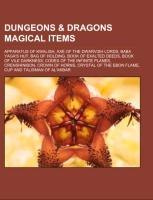
Zustellung: Sa, 31.05. - Mi, 04.06.
Versand in 3 Tagen
VersandkostenfreiBestellen & in Filiale abholen:
Source: Wikipedia. Pages: 36. Chapters: Apparatus of Kwalish, Axe of the Dwarvish Lords, Baba Yaga's Hut, Bag of holding, Book of Exalted Deeds, Book of Vile Darkness, Codex of the Infinite Planes, Crenshinibon, Crown of Horns, Crystal of the Ebon Flame, Cup and Talisman of Al'Akbar, Deck of many things, Eye of Vecna, Finder's Stone, Godsbane, Hand of Vecna, Heward's Mystical Organ, Horn of Change, Invulnerable Coat of Arnd, Iron Flask of Tuerny the Merciless, Jacinth of Inestimable Beauty, Johydee's Mask, Kuroth's Quill, List of major artifacts in Dungeons & Dragons, Machine of Lum the Mad, Magic item (Dungeons & Dragons), Mighty Servant of Leuk-o, Orbs of Dragonkind, Queen Ehlissa's Marvelous Nightingale, Recorder of Ye'Cind, Regalia of Might, Relic (Dungeons & Dragons), Ring of Gaxx, Rod of Seven Parts, Sphere of annihilation, Swords of Answering, Sword of Kas, Teeth of Dahlver-Nar, Throne of the Gods. Excerpt: In the Dungeons & Dragons role-playing game, magic items are common; however, some items are crafted by gods, fiends, or powerful wizards or clerics to be more permanent and potent than more ordinary magic items. These items are called artifacts. Major artifacts are generally unique and exist for a specific purpose. Less powerful or potent artifacts, or ones that are not unique, are generally called minor artifacts. In the Dungeons & Dragons fantasy role-playing game, a magic item is any object that has magical powers inherent in it. These may act on their own or be the tools of the character in whose hands they fall into. Magic items have been prevalent in the game in every edition and setting, from the original edition in 1974 until the modern fourth edition. In addition to jewels and gold coins, they form part of the treasure that the players often seek in a dungeon. Magic items are generally found in treasure hoards, or recovered from fallen opponents; sometimes, a powerful or important magic item is the object of a quest. Magical items are classified into several categories, depending to a certain degree on the game edition. These categories include weapons, armor, potions, rings, scrolls and miscellaneous (or wondrous) items, and another category called "rods, staves, and wands", which is sometimes separated into its three stated components. With version 3.5 of the D&D rules, these item categories were associated with particular "feats", that a player character can acquire. Weapons (such as magic swords) and armor in the D&D game serve to make characters more effective in combat. Commonly, magical weapons increase both the chances of hitting an opponent, as well as the amount of damage the weapon will deal, while magical armor decreases an opponent's chances of hitting the character. They are assigned enchantment ratings such as +1 or +5, indicating the strength of the increase or decrease. Some magic weapons and armor are outfitted with additional magical pr
Produktdetails
Erscheinungsdatum
21. August 2020
Sprache
englisch
Seitenanzahl
36
Herausgegeben von
Source: Wikipedia
Verlag/Hersteller
Produktart
kartoniert
Gewicht
93 g
Größe (L/B/H)
246/189/3 mm
Sonstiges
Paperback
ISBN
9781157032670
Entdecken Sie mehr
Bewertungen
0 Bewertungen
Es wurden noch keine Bewertungen abgegeben. Schreiben Sie die erste Bewertung zu "Dungeons & Dragons magical items" und helfen Sie damit anderen bei der Kaufentscheidung.










